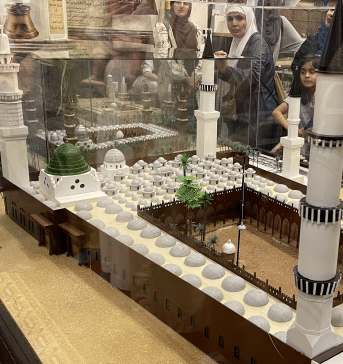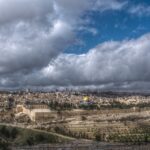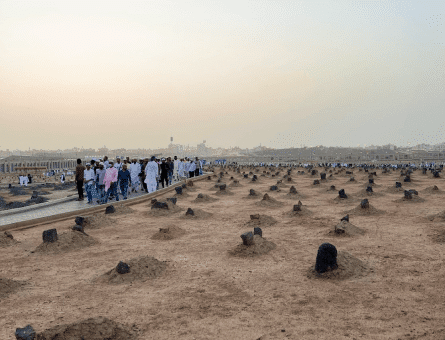Why is Medina important in Islam?
Madina, the sacred city of Prophet Muhammad (PBUH) is the light of every Muslim’s life. It is the second holiest city in Islam after Makkah and is the place where Masjid-e-Nabawi is situated.
Madinah is revered as the place where Prophet Muhammad (PBUH) established the Muslim community and the robust foundation of Islam after migration from Makkah in 622 CE. Keep reading to learn why Madinah is important in Islam.
What is Madinah?
 The name Madinah in long form is known as Madinat Rasul Allah (the city of Prophet (PBUH) of Allah SWT). However, for better understanding and ease of pronunciation, the name was shortened to Madinah which meant “The city,” or Madinah Al-Munawwarah “The Enlightened City.”
The name Madinah in long form is known as Madinat Rasul Allah (the city of Prophet (PBUH) of Allah SWT). However, for better understanding and ease of pronunciation, the name was shortened to Madinah which meant “The city,” or Madinah Al-Munawwarah “The Enlightened City.”
Madinah is ranked as the second holiest city in Islam. It is the city that gave refuge to the Messenger (PBUH) of Allah SWT and the early Muslims upon their migration from Makkah.
Madinah Al-Nabi was previously known as Yathrib, the agricultural centre of Saudi Arabia. Located almost in the middle of the Arabian Peninsula, Madinah was blessed with an abundant water supply which made it a popular stopping point for caravans and traders.
Madinah is the city that established the foundation of the Islamic community and gave the early converts a place to practise their religion peacefully. It is Madinah where Masjid Al-Quba, Masjid Al-Qiblatyn (the mosque in which the direction of prayer was changed to Kaaba) and Masjid-e-Nabawi (the mosque of the Prophet (PBUH) are located.
Importance of Madinah
Known as the second holiest city in Islam, Madinah is where Masjid Al-Nabawi (the Mosque of Prophet Muhammad (PBUH)) is located and it was the place where the Messenger (PBUH) of Allah SWT escaped to find shelter, protection, and peace from the never-ending persecution of the brutal Quraysh.
Soon after Hijrah (migration), the city of Madinah became the power base of the early Muslim community (Ummah). Some interesting facts about Madinah are mentioned below:
- Madinah is home to the three most significant and oldest mosques including Masjid-e-Nabawi, Masjid-e-Qiblatyn, and Masjid-e-Quba.
- Before the spread of Islam, the city was known as Yathrib and was renamed Madinah in honour of Prophet Muhammad (PBUH).
- Upon the completion of the Ottoman Hijaz Railway, the city became the southern terminus in 1908.
- Since 1920, more than 139 varieties of dates have been grown in Madinah.
- Madinah is situated in the most fertile part of the Hejaz territory.
Where Is Madinah located?
The city of Madinah is located in western Saudi Arabia within the boundaries of the Hejaz region of the Arabian Peninsula. The city of Prophet (PBUH) is situated at a distance of 340 km (210 miles) north from Makkah by road and 160 km (100 miles) inland from the Red Sea.
Population of Madinah
The current population of Madinah (as of 2022) is 1,545,000 which has increased by 1.78% since 2021.
Why Is Madinah the Holiest City in Islam?
 Madinah is one of the most sacred cities in Islam, making it a key destination for millions of Muslims travelling to Saudi Arabia for Hajj, or Umrah. Madinah is centred around Masjid Al-Nabawi, which is the mosque constructed by the Messenger (PBUH) of Allah SWT and the place where he (PBUH) is buried.
Madinah is one of the most sacred cities in Islam, making it a key destination for millions of Muslims travelling to Saudi Arabia for Hajj, or Umrah. Madinah is centred around Masjid Al-Nabawi, which is the mosque constructed by the Messenger (PBUH) of Allah SWT and the place where he (PBUH) is buried.
It is where Prophet Muhammad (PBUH) lived after the migration from Makkah, and he (PBUH) laid down the foundation of Islam. Madinah has played a pivotal role in both the life of Prophet Muhammad (PBUH) and the spread of Islam.
Anas (RA) narrated that Prophet Muhammad (PBUH)said: “For the believer, Madinah is the best place. If only they could understand its virtue fully, they would never leave it, and whoever departs from Madinah, having become disenchanted with it, Allah will send someone better to replace him. And whoever bears patiently the ordeals of Medina, for him shall I be an intercessor (or witness) on the Day of Qiyamah.” (Muslim) Anas (RA) also reported that, “Whenever the Prophet (PBUH) returned from a journey and observed the walls of Madinah, he would make his mount go fast, and if he was on an animal (i.e. a horse), he would make it gallop because of his love for Madinah. [Bukhari]
What Does Medinah Mean in Islam?
Before the advent of Islam, Medina was called “Yathrib,” which was a self-made name given to the city by its people and literally had no meaning. After migration from Makkah to Madinah and with the settlement of the Messenger (PBUH) of Allah SWT, the city of the Ansar got a fresh start.
Anas (RA) said, “The Ansar said on the day of the conquest of Makkah, when the Prophet (PBUH) gave some booties to the Quraysh, ‘By Allah, this is strange. Our swords are still dripping with the blood of Quraysh, and our spoils have been given to them!’”
This news reached the Prophet Muhammad (PBUH), and he summoned the Ansar and said, “What is this that I have heard about you?” They were people who never told lies, so they said, “It is what you have heard.”
To which Prophet Muhammad (PBUH) replied, “Does it not please you that the people are going back to their houses with worldly gains whilst you are going back to the houses with the Messenger (PBUH) of Allah SWT? If the Ansar were to follow a valley or mountain pass, I would follow the valley or mountain pass of the Ansar.” (Sahih Al-Bukhari, 3778 and Muslim, 1059)
History of Madinah
Formerly known as Yathrib, Madinah is an oasis city that dates far back to the 6th century BCE. After the war between the Romans and Jews, many Jews escaped Jerusalem and found refuge in Madinah.
Even though Nero had sent a massive Roman army under the leadership of Petra Leonidas to massacre the Jews in Yathrib, they somehow survived and by the time Prophet (PBUH) migrated to Madinah, the city was surrounded by Jews, eagerly waiting for the Messenger (PBUH) of Allah SWT.
Medina holds great importance in Islam. Known as the city of Prophet Muhammad (PBUH), it is the city where he (PBUH) settled down after migration to Madinah in 622 AD and stayed there until his last breath.
Previously called Yathrib, it was Medina where the Messenger (PBUH) of Allah SWT constructed the first mosque in the heart of the city after migration – Masjid-e-Nabawi. Additionally, Madinah was the city where he (PBUH) laid the foundation of brotherhood between the Muhajireen (those who had migrated from Makkah) and the Ansar (people of Madinah).
Why Did Prophet Muhammad (PBUH) Move to Madinah?
Between 620 AD and 622 AD, the Messenger (PBUH) of Allah SWT conveyed the message of Islam to the pilgrims of Madinah. As a result of the divine message, a total of 75 men and two women accepted Islam and invited Prophet Muhammad (PBUH) to Madinah.
Even though the heart of Allah SWT’s Messenger (PBUH) was in Makkah, the persecutions of the Quraysh – emotional, physical, social, and financial – had increased to an unbearable extent, making it impossible for Muslims to survive in the city.
Soon after, Prophet Muhammad (PBUH) was given permission from Allah SWT to migrate from Makkah to Madinah. The people of Madinah also assured complete protection to the Muslims and the beloved Prophet (PBUH) from the Quraysh.
Abu Hurairah (RA) reported that: “The Messenger (PBUH) of Allah SWT said, ‘I have been enjoined (to go to) a town which supersedes other towns. They say Yathrib, but it is Al-Madinah. It purifies people as the bellows eliminate the impurities of iron.’” (Sahih Al-Bukhari)
Aisha (RA), the wife of Prophet Muhammad (PBUH) reported: “When we came to Madinah, it was an unhealthy, uncongenial place. Abu Bakr (RA) fell sick and Bilal (RA) also fell sick; and when Allah’s Messenger (PBUH) saw the illness of his Companions he said: “O Allah SWT, make Madinah as beloved to us as you made Makkah beloved or more than that; make it conducive to health, and bless us in its sa’ and mudd’ (two standards of weight and measurement) and transfer its fever to Juhfa.” (Sahih Al-Bukhari)
What Is the Significance of Mecca?
 Makkah stands as the holiest city in Islam. Being home to the Holy Kaaba, Makkah is the destination of all Muslims to fulfil the obligations of Hajj and Umrah. Prophet Muhammad (PBUH) was born in Makkah and it was here that he (PBUH) was awarded Prophethood in the Cave of Hira.
Makkah stands as the holiest city in Islam. Being home to the Holy Kaaba, Makkah is the destination of all Muslims to fulfil the obligations of Hajj and Umrah. Prophet Muhammad (PBUH) was born in Makkah and it was here that he (PBUH) was awarded Prophethood in the Cave of Hira.
The city of Makkah has some of the most important monuments in Islam including Masjid Al-Haram, the Holy Kaaba, Muzdalifah, Mounts Safa and Marwa, the Well of Zamzam, Hajr-e-Aswad (Black Stone) and Maqam-e-Ibrahim.
Allah SWT in the Holy Quran says, “The first House (of worship) appointed for men was that at Bakka: Full of blessing and of guidance for all kinds of beings. In it are Signs Manifest; (for example), the Station of Abraham; whoever enters it attains security. Pilgrimage thereto is duty men owe to Allah,- those who can afford the journey; but if any deny faith, Allah stands not in need of any of His creatures.” (Quran 3:96-97)
“Remember Abraham said: “O my Lord! make this city one of peace and security, and preserve me and my sons from worshipping idols.” (Quran 14:35)
What’s the Difference between Mecca and Medina?
Both Makkah and Medina witnessed precious early moments in the history of Islam such as the birth of the last Messenger (PBUH) of Allah SWT and the revelation of the Holy Quran.
Being the centre of the three Abrahamic faiths, the city of Makkah has some of the most significant Islamic sites, including the Holy Kaaba, Masjid Al-Haram (the Great Mosque), and the well of Zamzam, Mounts Safa and Marwa, and Maqam-e-Ibrahim.
On the other hand, Madinah hosts Masjid Al-Quba, Masjid-e-Qiblaytn, Masjid-e-Nabawi and the grave of our beloved Prophet Muhammad (PBUH). Other than these, the only major difference between the cities is that Makkah is where Prophet Muhammad (PBUH) was born, whereas Madinah is where he (SAW) lived from migration till his last breath.
In Islam, both Makkah and Medina are considered safe havens for all living things, people, animals, and even plants. Abdullah ibn Zayd ibn Asim narrated that the Prophet Muhammad (PBUH) said:
“Abraham has made Makkah a sanctuary and prayed for its people and I declare Madinah to be a sanctuary in the same manner as Abraham declared Makkah a sanctuary. And I have prayed [to] Allah SWT (i.e. for the people of Madinah) in the same manner as Abraham did for the people of Makkah.” (Al-Bukhari)
Almighty Allah in the Holy Quran states: “And remember, Abraham said: ‘My Lord, make this a City of Peace, and feed its people with fruits, such of them as believe in Allah and the Last Day.’ He said: ‘(Yea), and such as reject Faith–for a while will I grant them their pleasure, but will soon drive them to the torment of Fire, an evil destination (indeed)!’” (Quran 2:126)
Prophet Muhammad (PBUH) said, “There will be no town which Ad-Dajjal (the anti-Christ) will not enter except Makkah and Madinah, and there will be no entrance (road) but the angels will be standing in rows guarding it against him, and then Madinah will shake with its inhabitants thrice and Allah will expel all the nonbelievers and the hypocrites from it.” (Bukhari)
Summary – Why Is Madinah Important in Islam?
Madinah, officially Medina Al Munawwarah (The Enlightened City) is the most sacred city in Islam after Makkah. The city of the Messenger (PBUH) of Allah SWT has great significance in Islamic history and in the lives of Muslims.
It is where Masjid-e-Nabawi and the grave of Prophet Muhammad (PBUH) are situated. Every year, more than 15 million Muslims have the great honour to perform Hajj and Umrah. After completing the rituals of pilgrimage in Makkah, Muslim pilgrims travel to Medina to offer 40 rakats of prayers in the mosque of Prophet Muhammad (PBUH). Throughout history, Madinah has proved to be the city of hope and light for Muslims worldwide.
Through His Names
New course with
Ustadh Shabbir Hassan















